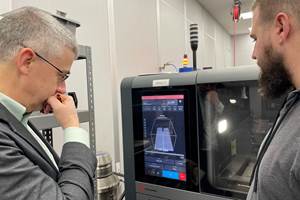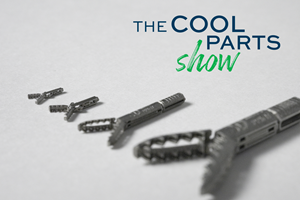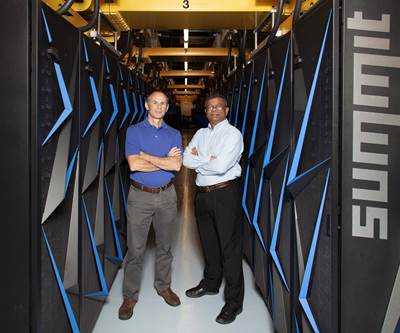New Opportunities for Quantum Physics: The Cool Parts Show #11
What does 3D printing have to do with quantum physics? We'll look at how the technology is enabling quantum physics research in this episode of The Cool Parts Show.
Share
Quantum physics researchers use close observation of atoms to reveal information about the surrounding world. Atoms contained inside an ultrahigh vacuum (UHV) chamber can be used to gather information about gravitational fields, enable quantum positioning systems and more. It’s possible that we could be moving from the digital age into the quantum age thanks to research and systems like this.
But what is additive manufacturing’s role in quantum physics? 3D printing could be the manufacturing method of choice for the next generation of these critical vacuum chambers. Utilizing AM to build these instruments will mean lighter, smaller and more efficient vacuum chambers that can open new research possibilities. In this episode we look at one such chamber, built by Added Scientific as a way of evaluating the printing material — AlSi10Mg — and its behavior under vacuum. | Season 2 of The Cool Parts Show brought to you by Carpenter Additive.
The Cool Parts Show is a video series from Additive Manufacturing Media that explores the what, how and why of unusual 3D printed parts. Watch more here.
Have a cool part to share? Email us.
Transcript
Stephanie Hendrixson
Two words: quantum physics. We're going to go there in this episode of the Cool Part Show.
Peter Zelinski
Thank you to Carpenter Additive, sponsor of The Cool Parts Show Season 2. How do you inspect additive manufactured parts? Lots of ways. Stick around to the end of the episode. We're gonna complete our tour of the Emerging Technology Center in Athens, Alabama. Now back to the show.
I'm Pete.
Stephanie Hendrixson
I'm Stephanie.
Peter Zelinski
We are with AdditiveManufacturing.Media.
Stephanie Hendrixson
And this is The Cool Parts Show our video series where we talk about cool, weird and unusual 3D printed parts.
Peter Zelinski
OK weird and unusual. So that's what I'm seeing here. This has got to be the weirdest looking cool part that we've ever discussed. I'm excited to learn about this. What is this thing?
Stephanie Hendrixson
OK, so this is an ultrahigh vacuum chamber to contain a cloud of atoms used in quantum physics research. So this was built as part of a feasibility study by a company called Added Scientific. They’re in the UK. And obviously, I'm not a quantum physicist, so I want to bring in someone who is also not a quantum physicist, but he is the engineer who designed this chamber. So this is Laurence Coles of added scientific explaining in a little bit more detail what this part is all about.
Laurence Coles
This is a ultrahigh vacuum chamber that we've produced using additive manufacturing. It's the world's first ultrahigh vacuum chamber that reaches x10 to the -10 millibar range, and it's used in the quantum technology sector. And for this particular application, it's used to trap cold atoms at its core using laser cooling and also magnetic fields. And with this type of chamber, we can produce atomic clocks, gyrometers, applications that might help with communication, quantum positioning systems and other quantum-based technologies.
Peter Zelinski
OK, so we talk about how weird this part looks. Maybe the weirdest, most visible thing is this particular wavy, warpy, kind of like a sponge lattice form, right? What is that?
Stephanie Hendrixson
Yeah. So one of the things that Lawrence mentioned is, is cooling. So these chambers keep the atoms really, really cold, like close to absolute zero so that they kind of condense into this cloud. And so part of the function of these lattices is to help with heat dissipation, to help maintain that cold temperature. But the weird gyroid pattern that you're seeing comes from proprietary software program that Added Scientific has developed to create designs like this.
Peter Zelinski
Okay. So that gyroid. So that's an example of a shape, surface shape and complexity, you could only get through additive manufacturing. So let's talk about that. What is the additive process that produced this?
Stephanie Hendrixson
So this was built on a Renishaw AM250, laser-based powder bed fusion. We've talked about that before. The engineer who built it, her name is Sarah Everton, and this part was printed initially and then it had to go through a couple of postprocessing steps. So a few rounds of heat treatment and then finish machining for these shiny faces that you see.
Peter Zelinski
OK. So that's how it was made. What's it made of? What's the material?
Stephanie Hendrixson
Right. So this is an aluminum alloy. It's aluminum silicon10 magnesium. And that's a good question, because when you have an ultrahigh vacuum chamber like this, actually the material is really important. You have to really understand how it's going to behave in these conditions.
Laurence Coles
During the development of this chamber. We've characterized this aluminum alloy in terms of its outgassing properties and during the application in ultrahigh vacuum, various contaminants and parts of the alloy itself can outgass into the environment inside the chamber. And by studying the material within this environment, we begin to understand how this material behaves when it's subjected to the ultrahigh vacuum. And that's something that's very important for this application, is this further characterization of the aluminum alloy beyond that of mechanical testing.
Peter Zelinski
OK, so the outgassing like I'm I'm really fascinated with that. So the pull of the vacuum is so strong that it can draw stuff out of the surface of the metal.
Stephanie Hendrixson
Right. And that stuff can kind of contaminate your cloud of atoms. So conventionally, a chamber like this would probably be machined out of stainless steel. And it's not because stainless steel doesn't have that
behavior; just about any material would outgas under ultrahigh vacuum conditions.But it's because we understand very well the behavior of stainless steel in those conditions.
Peter Zelinski
Right. So they're now trying to understand the same thing about this material, this aluminum alloy.
Stephanie Hendrixson
Right. Yeah. Understanding the material, understanding the 3D printed material. And they made a couple of choices to kind of help characterize the aluminum alloy a little bit better. So one of which is if you look at the inside of the chamber, it's still got this rough printed surface and there were concerns that a rough surface would outgas more than a smooth surface, and so to test that, they left it this way. But they actually found in doing experiments with this that the rough surface performed actually a lot better than they expected.
Peter Zelinski
OK, so here's what really strikes me about this. We're talking about outgassing. We're talking about this behavior under a vacuum. There was a time when the question about additive manufacturing was, can 3D printing and metal give you a quality part, the same kind of quality we expect of other processes, casting, forging? A concern not long ago was porosity. Right? The density, the integrity of the metal. It is apparently the case that concern has utterly been overcome because here's a part that is expected to hold a vacuum so well that it can isolate atoms, individual atoms for quantum physics research.
Stephanie Hendrixson
Right. And so, you know, even just a couple of years ago, holding the vacuum might have been the concern. But powder bed fusion has progressed to the point where it's reliable, but even more than that, it's controllable enough that we can print a chamber like this and be pretty confident it's going to hold the vacuum. So with this feasibility study was all about, it was not so much a test of 3D printing as it was a test of the material.
Peter Zelinski
OK. What else should we know about this part?
Stephanie Hendrixson
Well, so we talked about the material and we should say that aluminum is going to be lighter than stainless steel. And we talked about this lattice pattern. And the combination of those two things means that this vacuum chamber is actually a lot lighter than a conventional chamber. It's only about 245 grams, and that's about a 70% weight reduction over a stainless steel chamber made conventionally of about the same size.
Peter Zelinski
OK. Lightweighting. Yes. Advantage of additive manufacturing. But I think about lightweighting in terms of like aircraft parts or even auto parts. Why is a lighter vacuum chamber important? How does that help?
Stephanie Hendrixson
So I think Sarah explained it really well in an email. She called this chamber, the heart of a quantum system.
So if your chambers really heavy and awkward and difficult to move, it's going to limit your research possibilities. You're not going to be able to use it in as many places in as many ways. And it would limit the kind of devices you could put this into.
Peter Zelinski
Yeah. So wow, in this conversation, we're ticking off all these different additive manufacturing advantages. Right. There's the design freedom. There is improved cooling. There is lightweighting. So if we continue on that list, I would get to assembly consolidation. Is that going to play a role here?
Stephanie Hendrixson
Yes. So for this feasibility study, they wanted to be able to use off the shelf components with this system. So that's why it's the size that it is, so that it can mate with all of these other existing parts. But what you're hinting at is something that, yeah, they're going to be looking at in the future. So here's Lawrence again to describe the potential there.
Laurence Coles
The next development for us is to take this chamber developed for the feasibility study and to look at the wider vacuum system in the various quantum technologies and to look at consolidating parts, reducing the assembly, reducing the size of the assembly, the weight of the assembly, and then overall the power of the assembly, and also adding a lot of extra exciting features that we have planned coming up next.
Peter Zelinski
All right. I think I got this. Vacuum chamber holds a vacuum for quantum physics research. Isolates a cloud of atoms within this vacuum. This lattice for cooling. Cooling is very important to maintaining that vacuum. This lattice makes it more effective. A different material choice, an aluminum alloy makes this part lighter. But what that requires them to do is test the behavior of this material under vacuum, test it for the outgassing effect. Strikingly, this feasibility study is not a test of the feasibility of additive manufacturing, that's solid. It's a test of this material. And can they use this lightweight material to make this more complex, more effective form?
Stephanie Hendrixson
Yes. That's a great summary. One other thing to point out here is that, you know, quantum physics researchers, whether they know it or not, have kind of been limited by their equipment. There's only so many possibilities with existing vacuum chambers. And so something that Lawrence is really excited about is the opportunity to talk to these researchers about, OK, what is it that you're really trying to learn, what kind of tools you really need? And be able to develop chambers that are going to be purpose-built for the experiments that they want to run.
Peter Zelinski
Let me tell you what that makes me think about. So like we look at season two, the cool parts we've covered and they've been what? They've been and auto part, a part of a motor, it was a motor for a drone, but it's still a recognizable engine part. Glasses, the glasses you're wearing and an orthodontic mouthguard.
All throughout Season 2, we've seen how additive manufacturing is affecting everyday objects. Objects we recognize. The transformation there is powerful and profound. But beyond that, here's this application I wasn't aware of and even after this talk, I don't completely understand it. Quantum physics research. The possibilities available to quantum physics researchers are now expanded and taken farther because of additive manufacturing because of this new disruptive manufacturing process.And that leaves me wondering, like just how far will the impact of 3D printing go? How many different sectors and realms and worlds and fields of pursuit are there that are going to have new possibilities because of the special cool parts in their worlds?
Stephanie Hendrixson
Yeah, I don't know. But I really hope that we're gonna find more of those in Season 3. Yeah.
Peter Zelinski
So that's a wrap on this episode and this season of The Cool Part Show.
Stephanie Hendrixson
If you want to learn more about this vacuum chamber, you can find a link to our article in the show notes or at additivemanufacturing.media.
Peter Zelinski
Email us if you might like to see your cool part featured maybe in Season3. CoolParts@AdditiveManufacturing.media.
Stephanie Hendrixson
If you like the show. Be sure to subscribe. You'll be the first to know when Season 3 drops. Thank you for watching.
Peter Zelinski
Thanks so much.
I'm at Carpenter Additive's Emerging Technology Center in Athens, Alabama. Contract additive production facility. But production isn't done until measurement validates the part has been made to spec. Carpenter has every measurement tool it might need to perform that validation. Maybe most significantly of all, CT scanner for evaluating the inside of an additive part. Why so many measurement tools? Because additive manufacturing is a special process.
So printing is just one step in the whole process chain. And each of these steps can be very labor intensive, very time consuming. So we need to make sure that we're catching deviations or non-conformists at every step of that. So that doesn't propagate down and causes an issue at the very end. When we catch those deviations or a couple of things that can happen. We can either rework that part and get it back into the standard flow or in the worst case, we have to scrap that and start again.
William Herbert
Additive is such a new, relatively new fabrication technique, we don't have all of the statistical data that some of our other fabrication techniques have. I fully expect as we get more data around the materials performance, we're going to require less and less actual in-process inspection as we get better at predicting the outcomes, as we get better at identifying deviations in real time.
Related Content
Freeform: Binder Jetting Does Not Change the Basics of Manufacturing
Rather than adapting production methodologies to additive manufacturing, this Pennsylvania contract manufacturer adapts AM to production methodologies. In general, this starts with conversation.
Read MoreTwo 12-Laser AM Machines at Collins Aerospace: Here Is How They Are Being Used
With this additive manufacturing capacity, one room of the Collins Iowa facility performs the work previously requiring a supply chain. Production yield will nearly double, and lead times will be more than 80% shorter.
Read MoreMicro Robot Gripper 3D Printed All at Once, No Assembly Required: The Cool Parts Show #59
Fine control over laser powder bed fusion achieves precise spacing between adjoining moving surfaces. The Cool Parts Show looks at micro 3D printing of metal for moving components made in one piece.
Read MoreAt General Atomics, Do Unmanned Aerial Systems Reveal the Future of Aircraft Manufacturing?
The maker of the Predator and SkyGuardian remote aircraft can implement additive manufacturing more rapidly and widely than the makers of other types of planes. The role of 3D printing in current and future UAS components hints at how far AM can go to save cost and time in aircraft production and design.
Read MoreRead Next
3D Printing the World's Smallest Flow Measurement Probes
Vectoflow has found its niche in 3D printing flow measurement probes featuring up to five holes on a probe head diameter as tiny as 0.9 mm.
Read MoreCan 3D Printed Metal Hold a Vacuum…for Quantum Physics Research?
A feasibility study shows that laser sintered AlSi10Mg can build an ultrahigh vacuum chamber capable of holding a cloud of rubidium atoms. The promise? Lighter, more portable designs to bring research out of the lab.
Read MoreHow Exascale Computing Will Enable Born-Qualified AM Parts
ExaAM, a high-fidelity simulation tool, promises to reduce trial-and-error in additive manufacturing and help create metal 3D-printed parts that are qualified from the beginning.
Read More
.jpg;width=70;height=70;mode=crop)











.JPG;maxWidth=400;quality=70)


